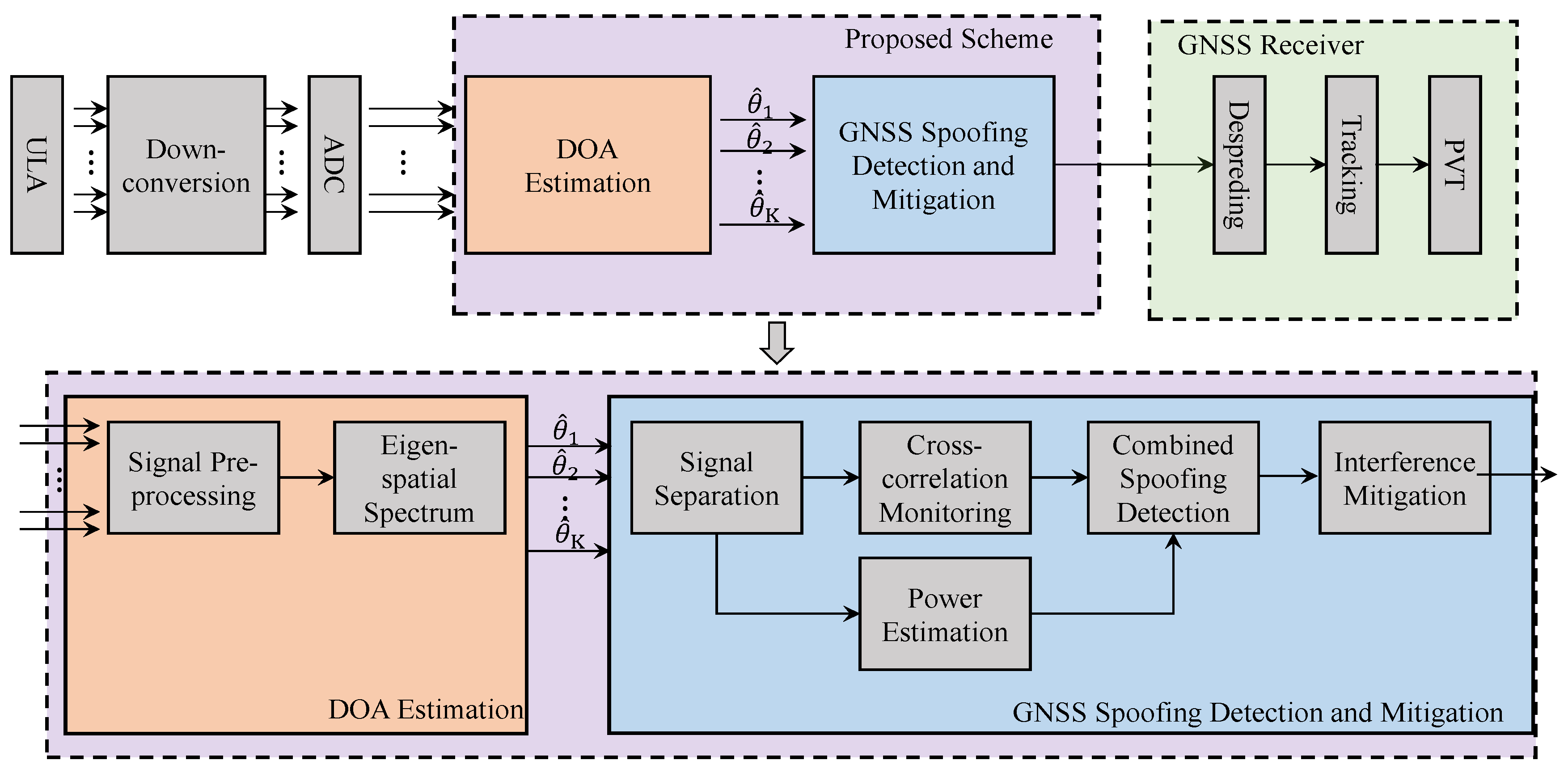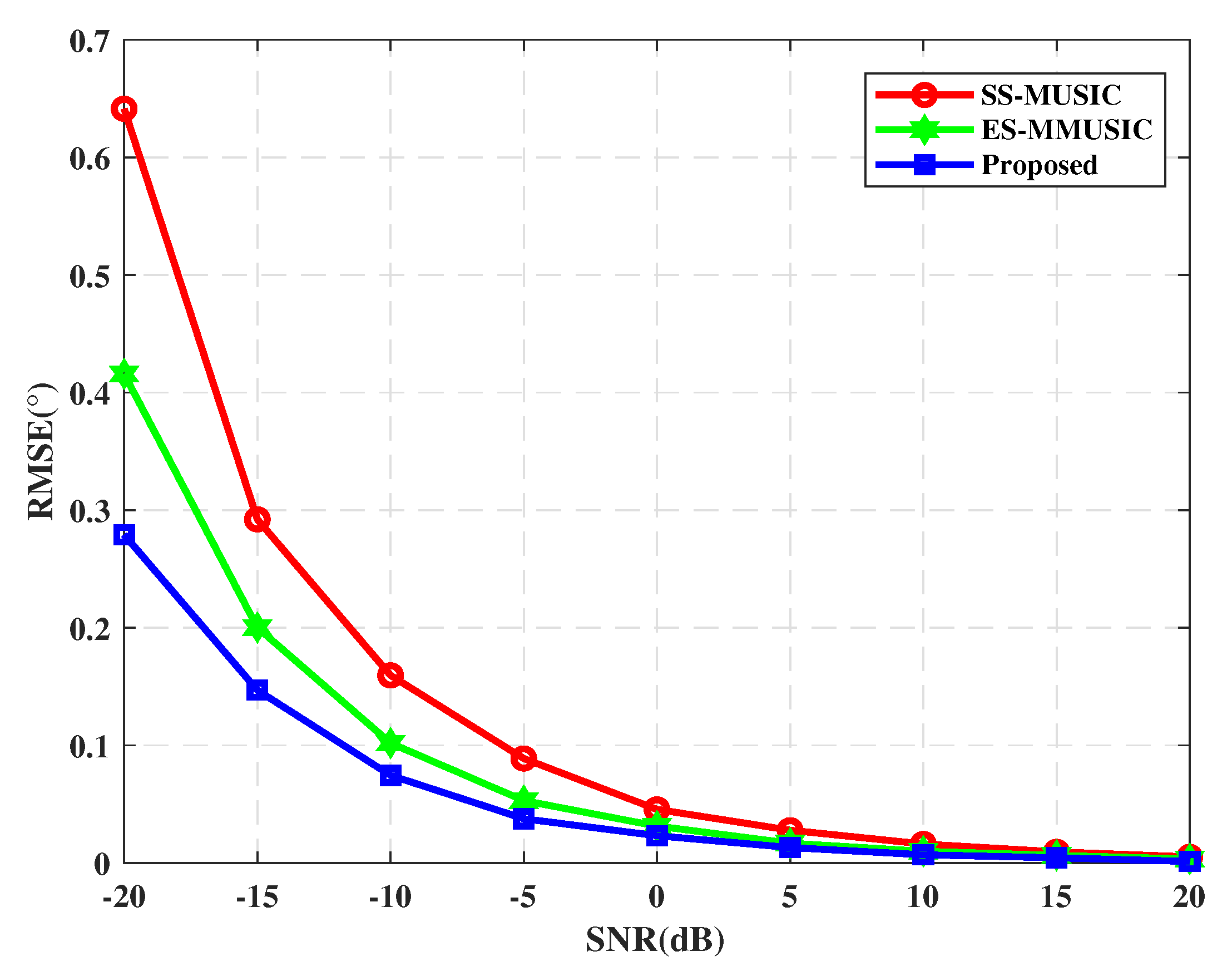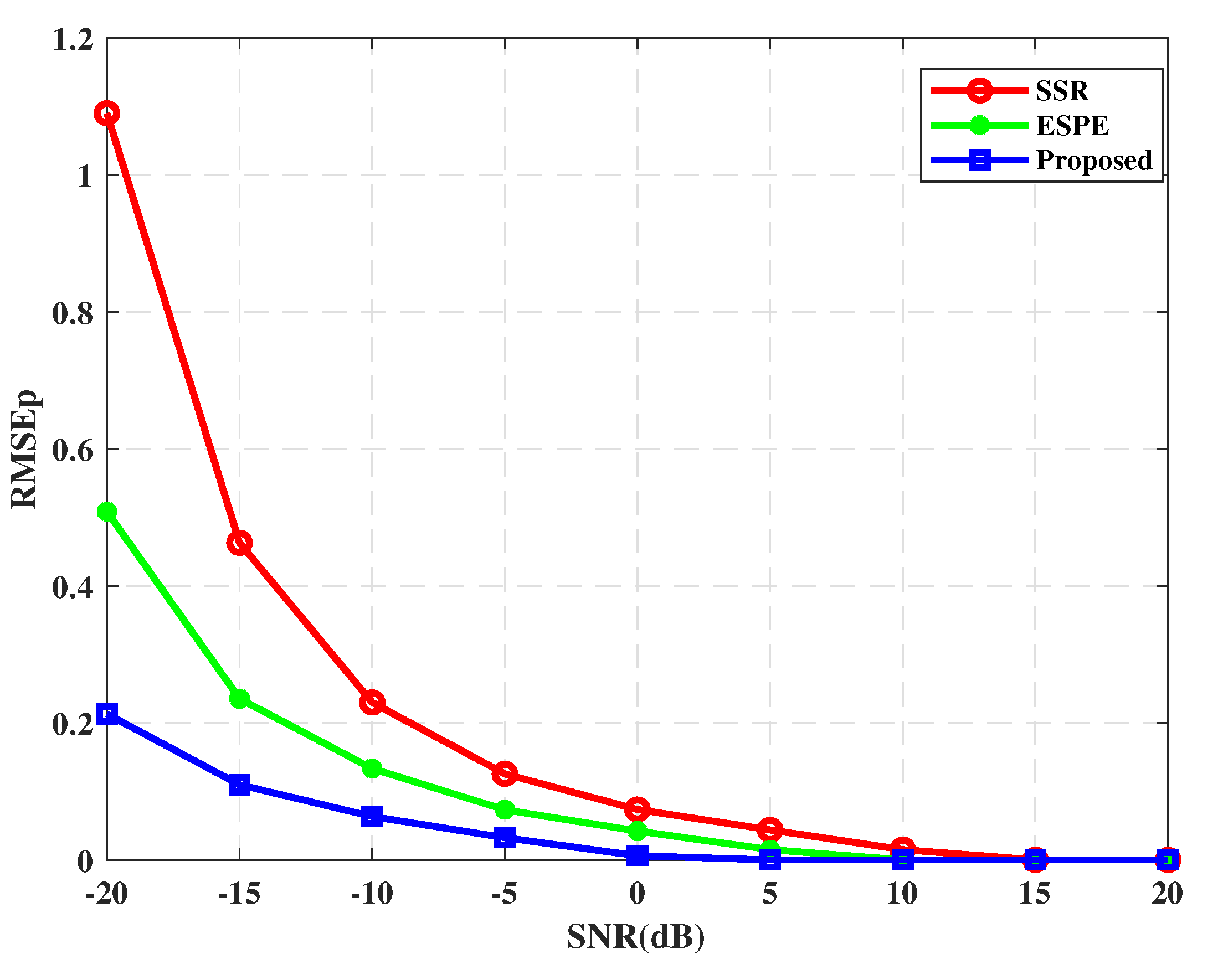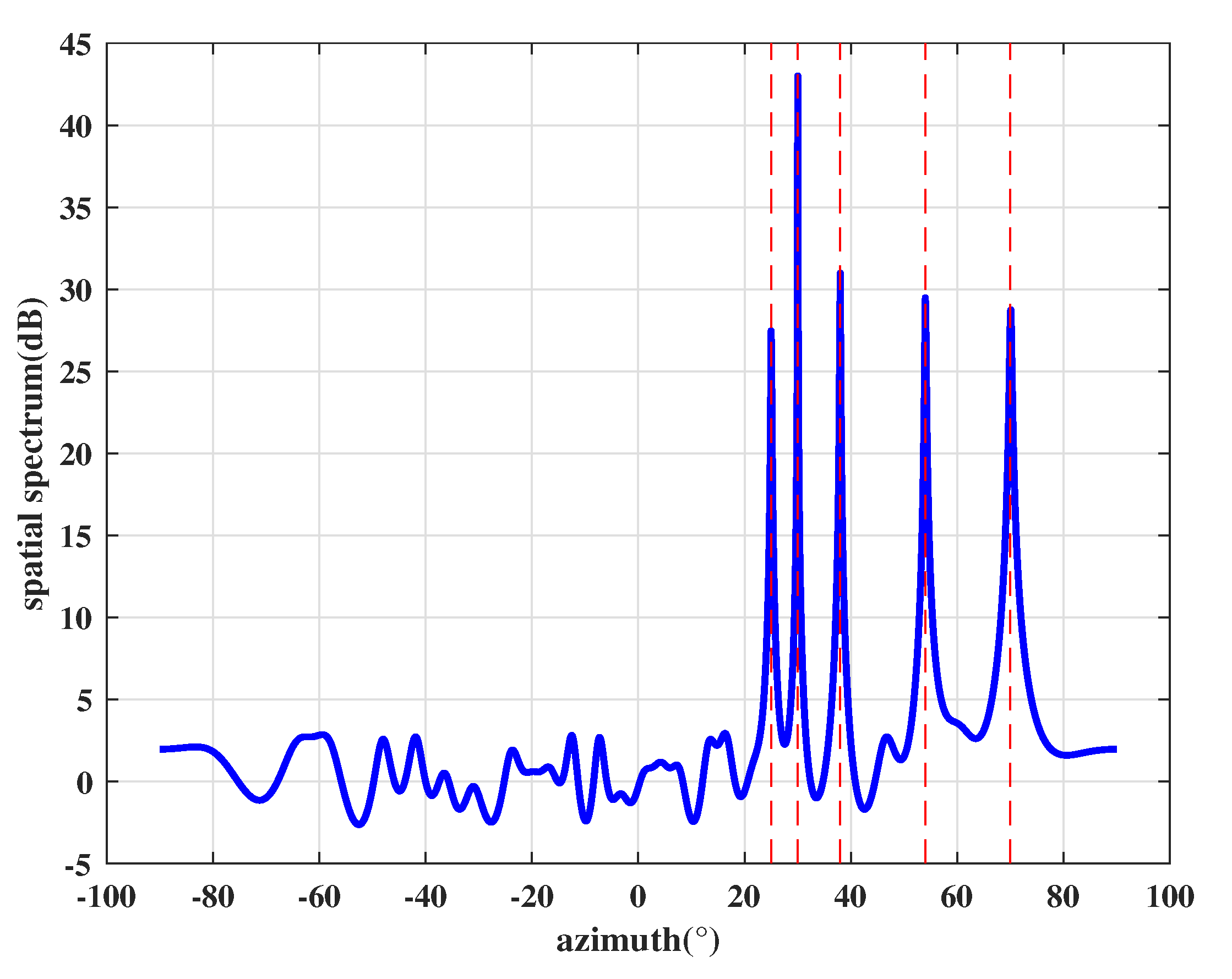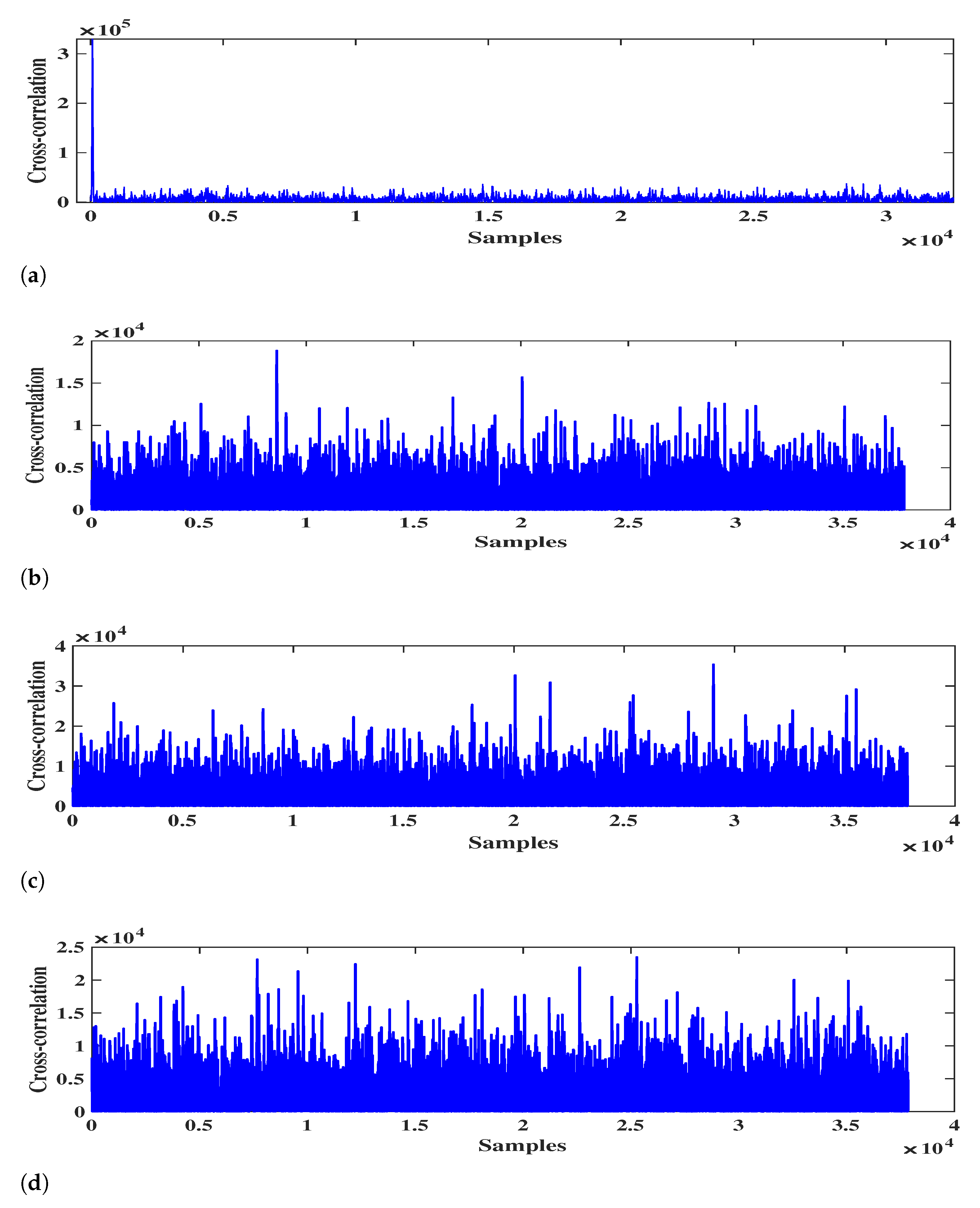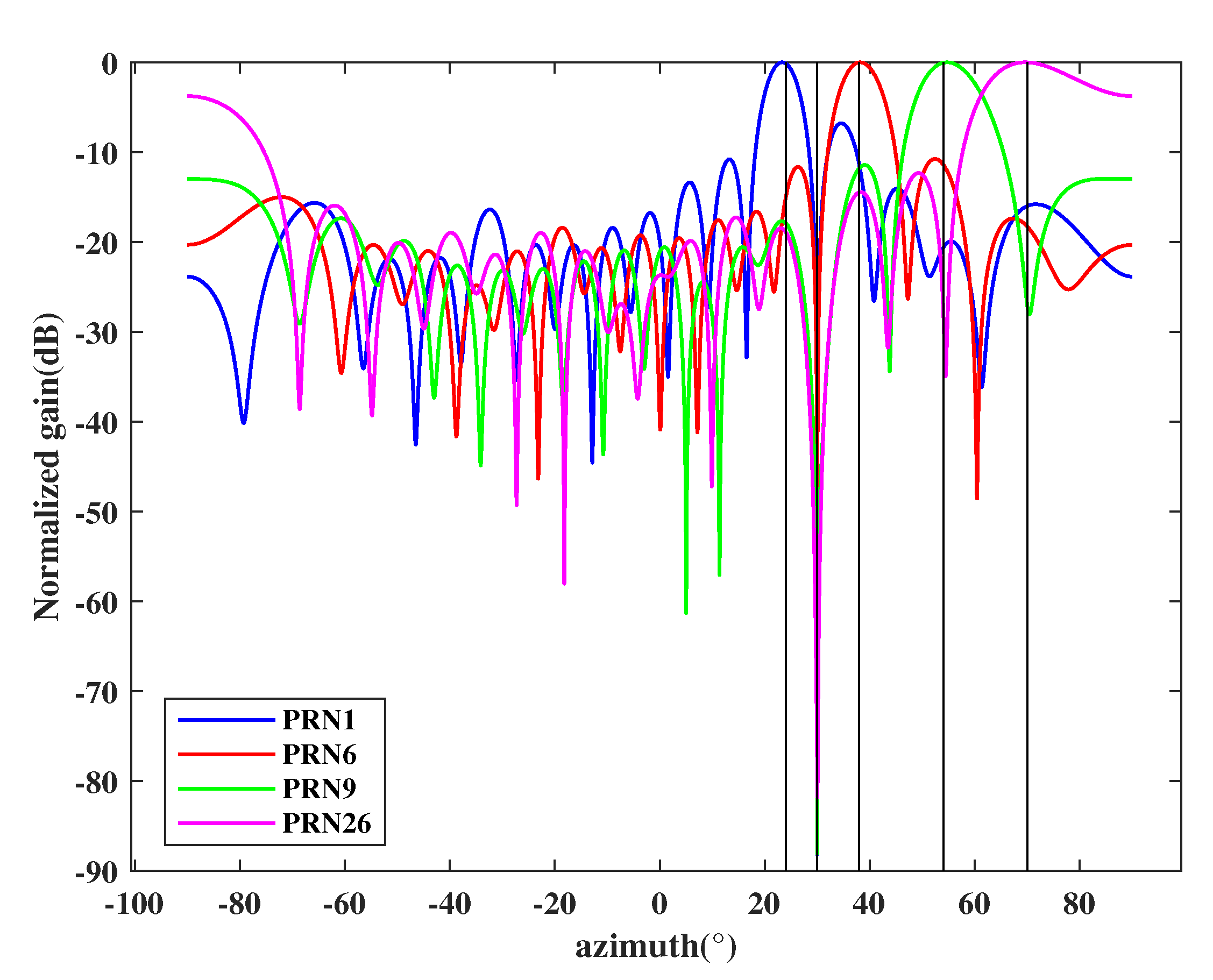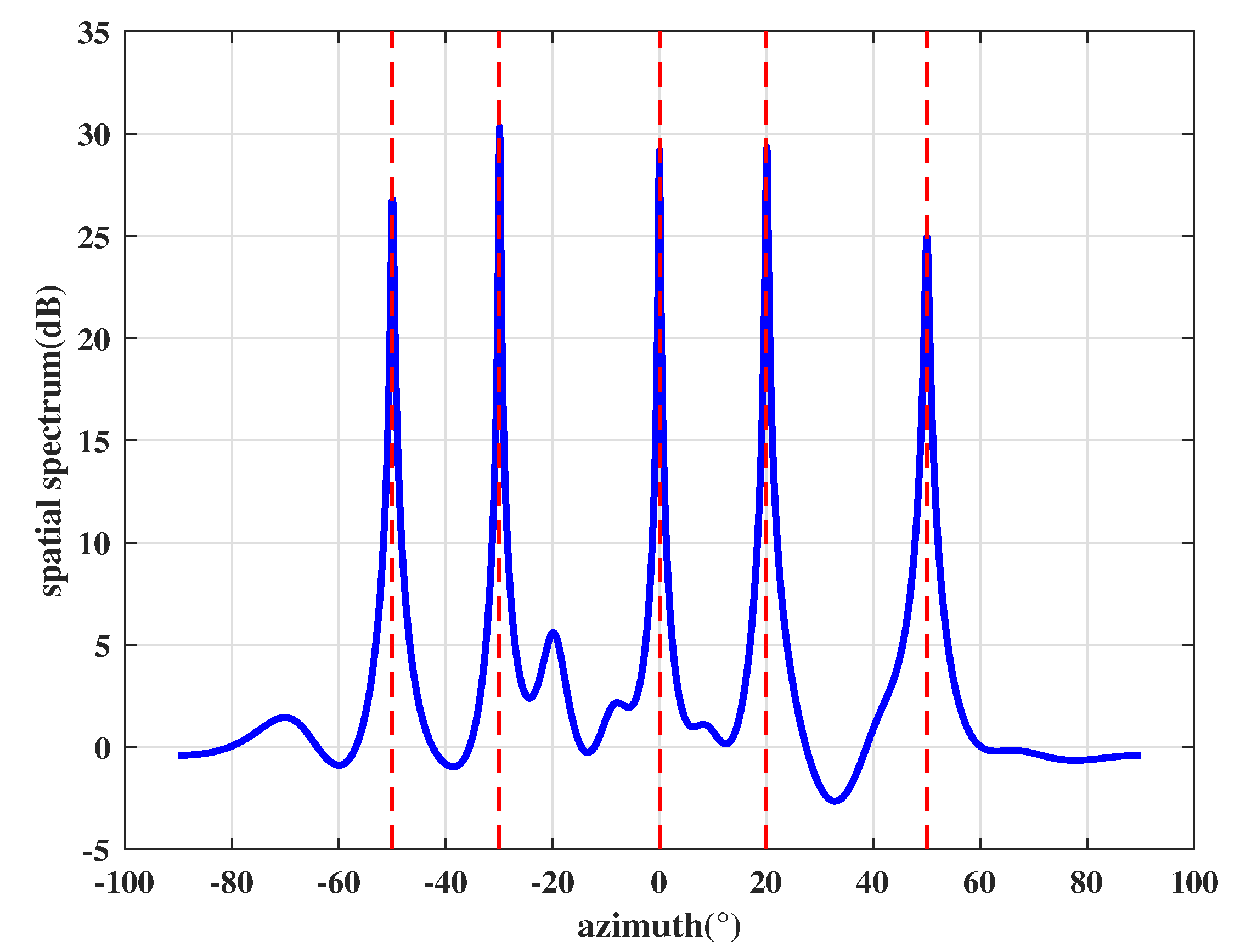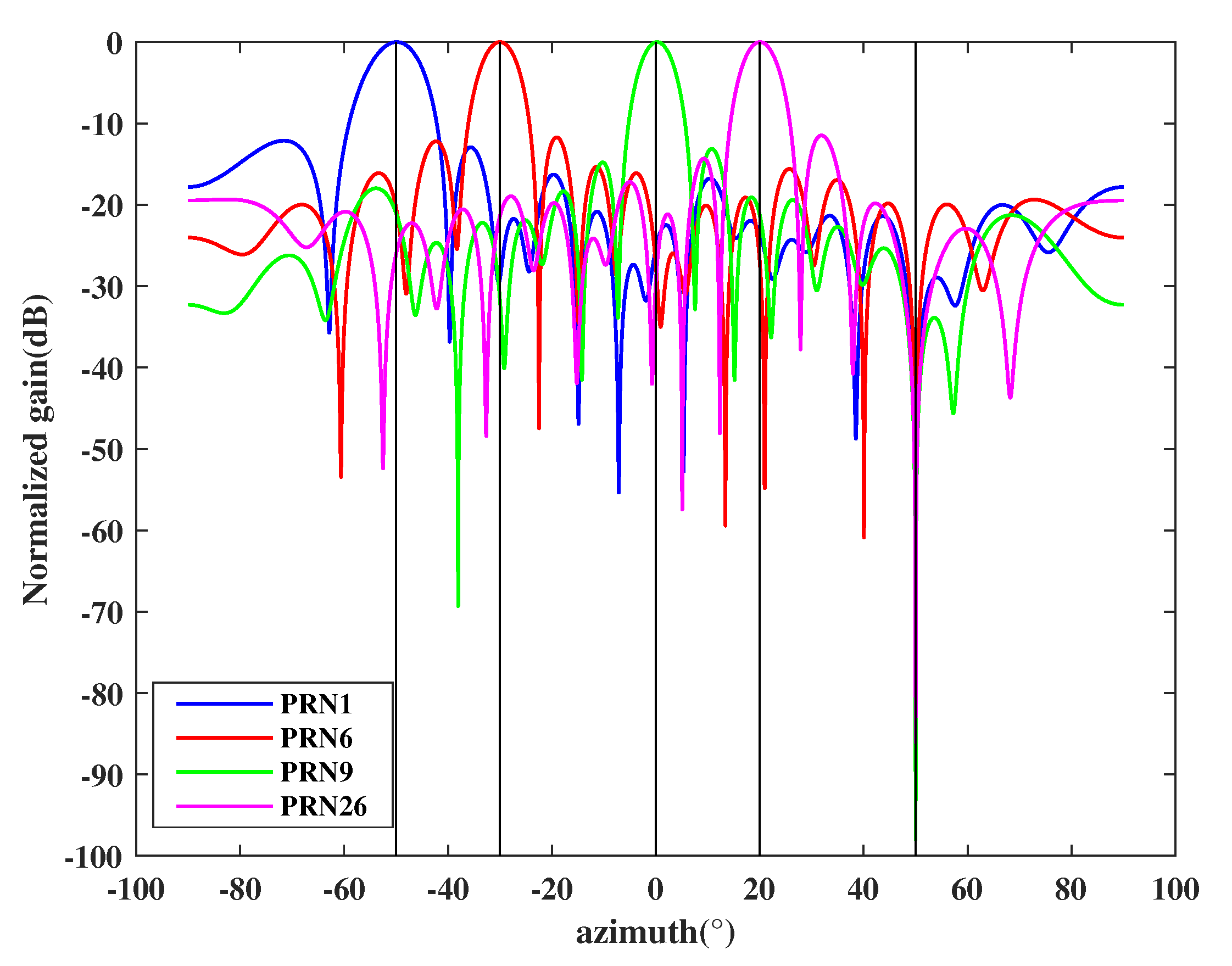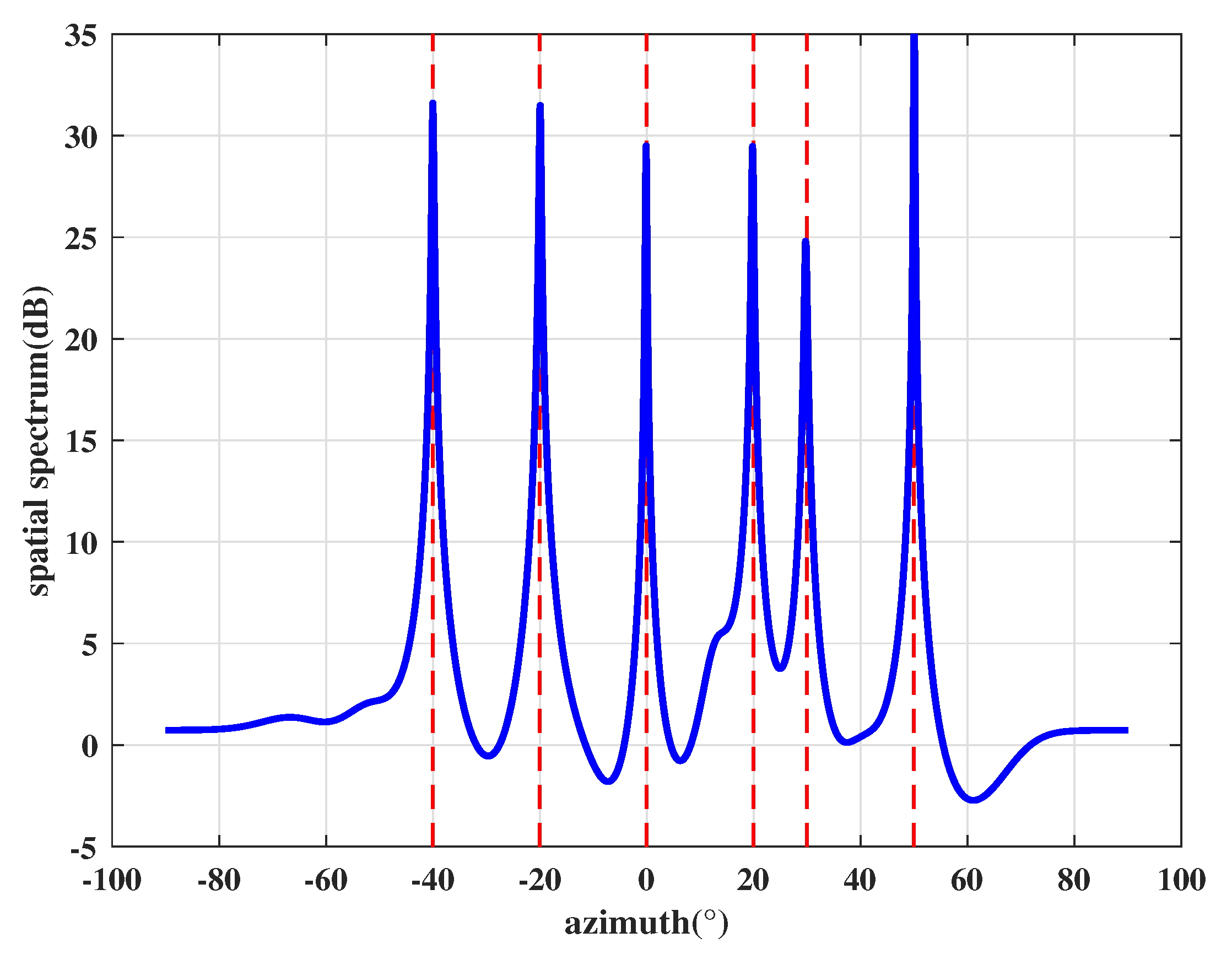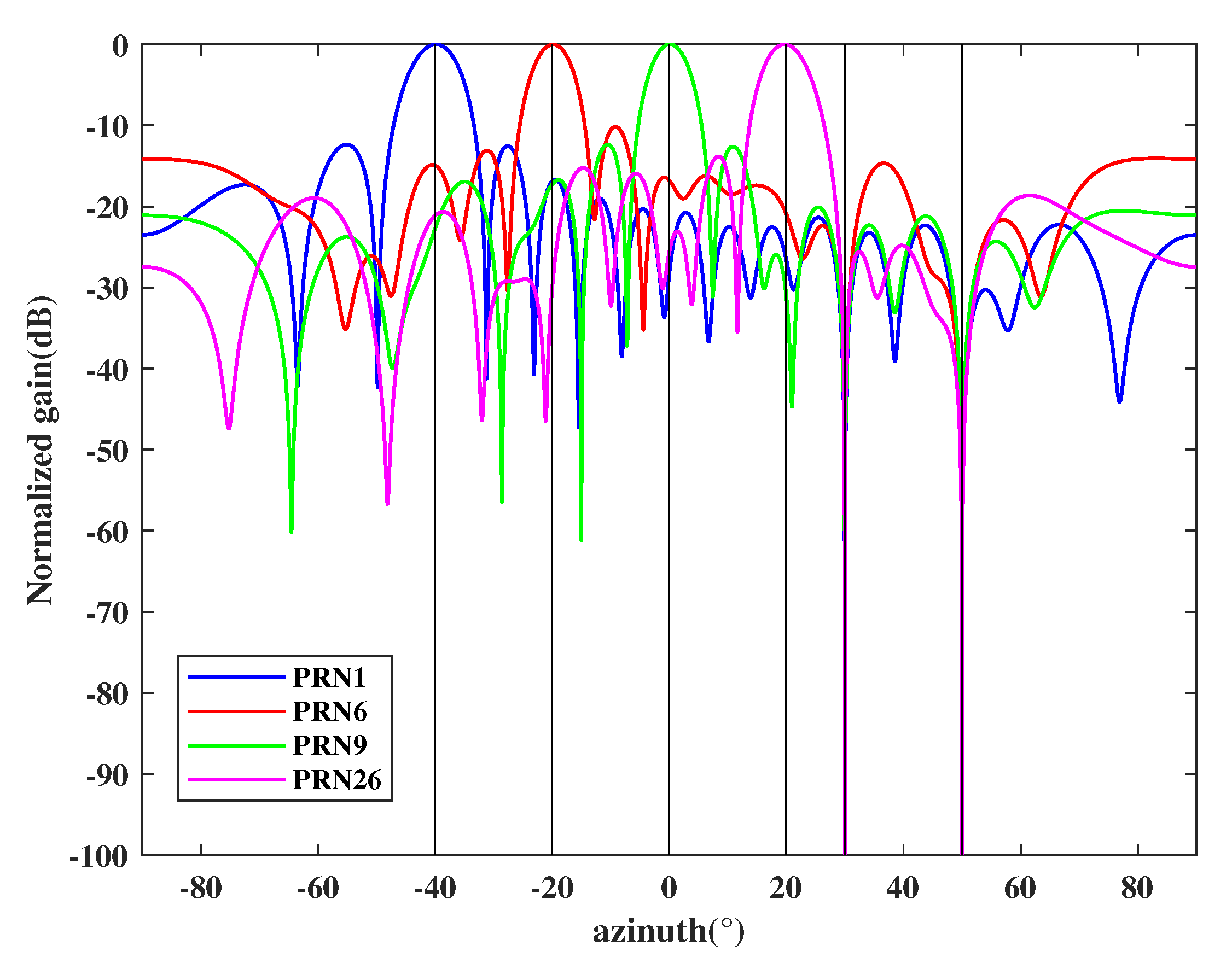4.2. Spoofing Detection and Mitigation
In this subsection, more simulation results have been provided to prove the performance of the proposed GNSS spoofing detection and mitigation method in different application scenarios. To obtain time and three-dimensional position coordinates, four genuine satellite signals are considered in our simulation. The signal received by the antenna array is down-converted to an intermediate frequency of 4.092 MHz, and the sampling frequency is 37.85 MHz. Each C/A code chip has 37 sampling points, and the corresponding spreading gain is . The sampling point length of the data block and reference data block used in this simulation is N = 37,000, and the data length of 20 ms is selected for simulation. In order to improve the estimation accuracy of the covariance matrix, 7 pairs of data blocks and are used. In the simulation, it is assumed that spoofing and multipath are aligned with the code phase of the satellite signal within 6 samples (0.16 chips) and 13 samples (0.35 chips), respectively. The power of the satellite signals at the receiver is −160 dBW. Furthermore, the SNR of the satellite signal at the receiver is −20 dB while the SNR of the spoofing and multipath varies according to different scenarios. For each simulation scenario, 1000 Monte-Carlo trials are performed for power estimation. The following is divided into three different scenarios for simulation verification.
In the first experiment, we consider four genuine signals PRN1, PRN6, PRN9, and PRN26 that are transmitted from 25
, 38
, 54
, and 70
, respectively. It is assumed that there is one spoofing that comes from 30
, which contains four counterfeit signals with the same PRNs as the four genuine satellite signals. The power of each spoofing signal is 3 dB larger than its corresponding genuine signals. According to the proposed method, we first perform DOA estimation and the obtained spatial spectrum is shown in
Figure 4. The red dashed lines indicate the DOAs of incident sources.
Figure 4 illustrates that the proposed DOA estimation based on preprocessing and improved eigen space can accurately estimate the incident direction of all signals.
After that, the power is estimated by Equation (
19), where the Equation (
24) is used to separate received signals. For simplicity, we use SNR to represent the power of each signal. The estimated SNR corresponding to each DOA is shown in
Table 3, which is arranged in descending order. Then, we perform cross-correlation operations on any two spatial signals. Taking the spatial signal with 25
direction as an example, the cross-correlation results between it and 30
signal, 38
signal, 54
signal, 70
signal are shown in
Figure 5. It can be seen from
Figure 5 that the cross-correlation peak only exists between the 25
signal and 30
signal. Similarly, we perform cross-correlation operation on the remaining signals and count all cross-correlation peaks in
Table 4.
It can be seen from
Table 3 that the power difference between the strongest
signal and the average of
,
,
and
signals is as high as 5.65 dB. According to the proposed method, the DOA corresponding to
signal with the highest power is assumed to be the direction of the spoofer. In addition, it can be seen from
Table 4 that there are four correlation peaks in the cross-correlation results between
signal and other signals. Therefore, it is obvious that the strongest signal has the same PRN code as the other four signals, which indicates that the signal in 30
direction is the spoofing.
Based on the above results, the output signals can be calculated by Equation (
30) and the final beam pattern of the array is shown in
Figure 6. It shows that the proposed interfere mitigation technology can form deep null steering in the DOA of the spoofing while obtaining the maximum gain of satellite signals.
In the second example, in order to verify the effectiveness of the proposed method in multipath environment we consider four authentic signals PRN1, PRN6, PRN9, and PRN26 coming from −50−30, 0 and 20 direction. Furthermore, one multipath signal, which pertains to PRN6, comes from 50 direction. In this simulation, the SNR of satellite signal PRN6 is 1 dB higher than other satellites, and the multipath signal has the same power as the other signals.
The estimated spatial spectrum is shown in
Figure 7, which shows the proposed DOA estimation algorithm can effectively obtain the directions of all signals (including authentic signals and multipath). After that, we estimate the power of each signal and sort them in descending order, as shown in the
Table 5. Then, the cross-correlation results of all signals are shown in
Table 6.
As
Table 5 and
Table 6 show, the strongest
signal is only 1.26 dB higher than the average of the other signals and there is only one correlation peak in the cross-correlation results between
and
. Therefore, according to the proposed anti-spoofing method, the strongest signal cannot be the spoofing. Furthermore, there is a cross-correlation peak between
signal and
signal, which is the feature that two authentic signals do not have. Since the multipath signal is the attenuation of genuine signals, the power of multipath is less than its corresponding authentic satellite signal. Based on the above analysis, it can be seen that the
signal is the genuine signal while
signal is a multipath whose direction is 50
.
It is worth noting that this case assumes the multipath and the other three authentic signals have the same power, which is not typical in actual situations. Even in this environment, the proposed method can detect that there is only multipath interference but no spoofing signal, which shows that strong multipath will not affect the accuracy of the spoofing detection. Accordingly, the monitoring of the number of cross-correlation peaks can minimize the impact of power estimation errors on the spoofing detection results.
According to the above results, the final signal vector can be calculated by Equation (
31) and the beam pattern of the array in this case is shown in
Figure 8. It shows that the proposed anti-spoofing technology can form deep null steering in the DOA of the multipath. Since the beamforming for each satellite is performed, the authentic signals can also get the maximum gain.
Final simulation example considers one spoofing, one multipath, and four authentic signals (PRN1, PRN6, PRN9, and PRN26), where the multipath signal pertains PRN1 and the spoofing transmits four spurious signals that have the same PRNs with the authentic signals. We assume each spoofing is only 0.4 dB higher than the authentic signals [
16], and the multipath signal is 1 dB lower than the authentic signals. In this simulation, the DOAs of the PRN1, PRN6, PRN9, and PRN26 are −40
, −20
, 0
, and 20
respectively. The spoofing and the multipath are incident from 50
and 30
, respectively. The estimated spatial spectrum is shown in
Figure 9 and based on which the estimated DOA can be obtained. Then we estimate the source power corresponding to all spatial DOAs and arrange them in descending order as shown in
Table 7. After that, all signals are used to perform cross-correlation, and the result is shown in
Table 8.
We can see from
Table 7 and
Table 8 that the strongest signal and other signals have correlation peaks. The power difference between it and the average value of other signals is 3.04 dB, and the existence of multiple correlation peaks indicates that the strongest signal in 50
direction contains the PRN codes of the other signals, which is the feature that multipath and authentic signals do not possess. Thus 50
is the spatial direction of the spoofing. Moreover, it can be seen from
Table 8 that the signal in 30
direction not only has correlation peak with the spoofing but also has a cross-correlation peak with the signal in −40
. Due to the orthogonality of PRN codes, there is no possibility of cross-correlation peaks between two genuine satellite signals. In terms of power, the signal power in −40
direction is higher than that in 30
direction. Obviously, the signal with 30
direction is a multipath signal. It is illustrated that the proposed algorithm can effectively distinguish spoofing from multipath and satellite signals under the assumption of single antenna transmission, even if the power of each spoofing is not significantly greater than genuine signals.
Since we have obtained the direction of the multipath and spoofing, the subspace oblique projection method in Equation (
26) is adopted to suppress them. After that, the final output of each authentic satellite signal can be calculated by Equation (
28) and the array beam patterns are shown in
Figure 10. It can be seen that the proposed countermeasure can not only form nulls in the direction of multipath and spoofing but also maximize the gain of each authentic satellite signal.
